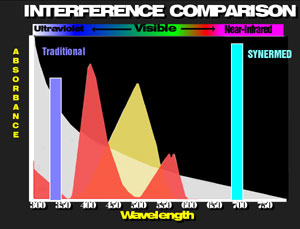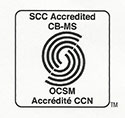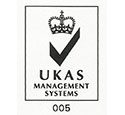Phosphorous
 |
 |
 |
|
Low levels of chromatic substances cause severe interference with traditional phosphorus assays. Even clear sera may contain high levels of free fatty acids, phospholipids or abnormal proteins which form turbidity during the course of traditional assays.
Phosphorus assays have been used to monitor intravenous nutrition in geriatric poulations receiveing Intralipid®. The Intralipid causes severe interference in traditional phosphorus assays providing misleading information.
The Synermed® phosphorus assay avoids interference from abnormal proteins, chromatic substances and other turbidity related interferences by means of kinetic infrared detection.
-
-
-
- Liquid-Stable Ready-to-Use Reagents
- Minimal Interference from Serum Bilirubin, Hemoglobin and Lipemia
- Avoids Error from Abnormal Proteins
-
-
Principles of the Reaction
Synermed provides liquid, stable reagents for the measurement of phosphorus. In the Synermed method, polyvinylpyrrolidone is used to catalyze the reaction of phosphorus with molybdate. The phospho-molybdate complex is reduced in the second step, producing an intense blue infrared-absorbing chromophore which can be quantitated between 600 nm and 850 nm. The infrared detection of the Synermed method eliminates chromatic interferences from hemolysis, bilirubin, and lipemia. The Synermed method is also free from interference from protein.
Polyvinylpyrrolidone [PVP] catalyzes the formation of the molybdate polymer which reacts with phosphorus to form a phosphomolybdate complex.
PVP
H3PO4 + MoVI -> 12-molybdophosphoric acid + H+
(yellow)
The phosphomolybdate complex is reduced to form an intense infrared absorbing blue chromophore which is quantitated spectrophotometrically between 600 and 850 nm.
12-molybdophosphoric acid + e- -> phosphomolybdenum blue
Analytical Range
Most applications of this procedure have been found to be linear to at least 20 mg/dL.
Special Performance Characteristics
- The Synermed Phosphorus methodology was correlated to a widely accepted colorimetric method. The calculated linear regression on 50 samples ranging from approximately 1.9 to 9.1 mg/dL with Synermed results on the Y-axis is Y + 0.98X + 0.1 with a correlation coefficient of 0.998.
- The sensitivity of the procedure is such that an absorbance change of 0.001 will detect as little as 0.02 mg/dL.
- The within run precision of the method using an automated analyzer was determined by assaying 30 replicate samples of quality control materials at two levels of phosphorus concentrations yielding the following results:
Mean SD CV 2.6 mg/dL 0.04 1.7% 5.7 mg/dL 0.11 1.9% - The run to run reproducibility of the method as applied to an automated analyzer was determined from the values obtained by 5 replicate analyses of quality control material assayed over a 22 batch period. The following results were obtained:
Mean SD CV 5.0 mg/dL 0.19 3.6% 6.6 mg/dL 0.12 2.0%
Product Packaging and Storage
| Cat No. | Product Name | Packaging | Package Volume (mL) | Storage |
| IR110-X | Phosphorus | 1x250 mL + 1x100 mL | 350 | 0-4° C |
| IR110 | Phosphorus | 3x250 mL + 3x100 mL | 1,050 | 0-4° C |
| IR111-L | Phosphorus Molybdate | 6x500 mL | 3,000 | 0-4° C |
| IR112-L | Phosphorus Catalyst | 6x500 mL | 3,000 | 0-4° C |
| IR110-911 | Phosphorus | 4x50 mL + 2x40 mL | 280 | 0-4° C |
| IR110-WK | Phosphorus | 3x25mL + 3x10mL | 105 | 0-4° C |
Connect with us
Certifications
 |
 |
 |
 |
||

